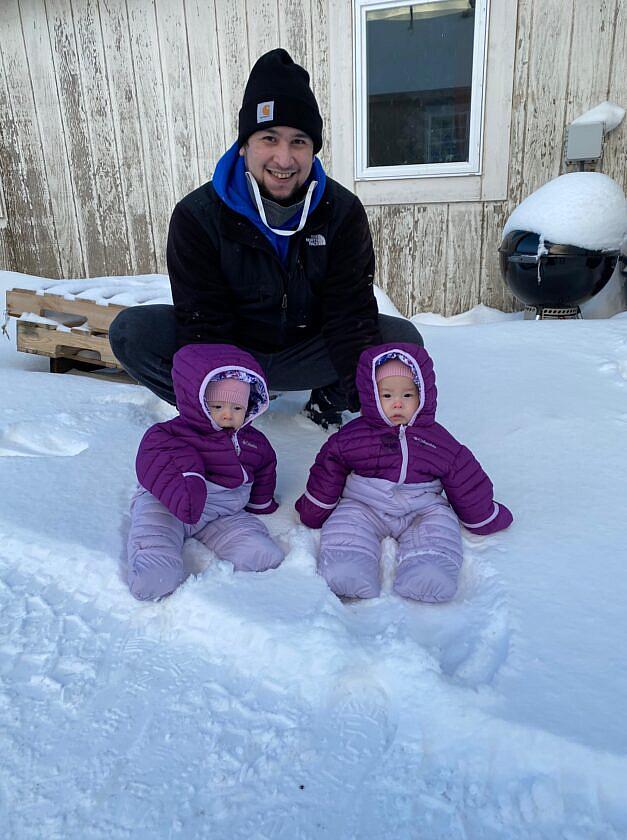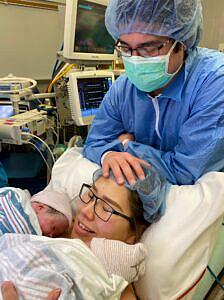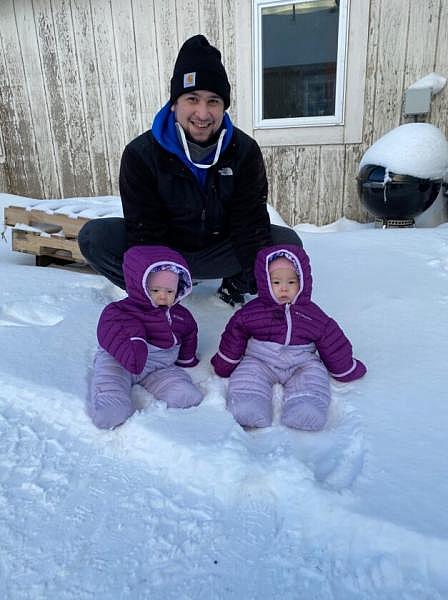To keep COVID-19 out of her remote community, one woman spent 10 weeks in isolation waiting to deliver twins
This story by Claire Stremple was produced as a project for the USC Annenberg Center for Health Journalism’s 2020 National Fellowship.
Her other stories include:

Twins Anna and Mila with their father, John Melovidov, in St. Paul.
(Image courtesy of the family)
Alaska women who live in rural and remote communities usually travel to city centers to give birth against incredible geographical odds. COVID-19 can make a hard trip longer and lonelier. That disproportionately affects Alaska Native women, who are more likely to live in remote areas.
Cara Lestenkof-Mandregan after the birth of twins Ana and Mila. (Image courtesy of the family)
“Everybody was just thrilled for us,” she said.
They live on St. Paul Island, an Unangan (Aleut) community that’s part of the Pribilof Islands. It’s in the middle of the Bering Sea. Cara works at the clinic as a health aide, so she knows the drill when someone gets pregnant. The first appointment is on the island, then a referral out to Anchorage.
“Typically, if it’s low risk pregnancy, all as well, their prenatals will happen here in St. Paul because they’re capable of doing that,” she said.
There’s usually one more ultrasound in Anchorage and then everything happens on the island until 36 weeks when women leave to wait to deliver near a hospital.
“That’s typically what’s done here, but that’s not the story that I have,” Lestenkof-Mandregan said.
At that first Anchorage appointment, Cara and her partner found out they were expecting twins. It’s considered a high risk pregnancy.
“I had the doctor come in and tell me all these things that could potentially go wrong. And that after 16 weeks, I would need to travel out to Anchorage every two weeks for appointments. My jaw dropped. Just imagining the fact that you know, I’m 800 miles away, if anything were to go wrong, I know how long it takes to get a medevac here,” she said.
This was January. COVID-19 hadn’t yet shaken the system in Alaska, so she weathered the bi-weekly trips between St. Paul and Anchorage.
But by March travel wasn’t recommended. Hospitals postponed elective procedures. Her clinic only let patients in the door. As a health aide, Cara has watched colds and flus spread across the island like wildfire. She said it started to feel scary, but she still had to travel to Anchorage for her appointments. She didn’t want to be the one who brought the virus back from the city. She says the risk of illness weighed on her each trip.
“It was very nerve wracking. We didn’t know what to expect, I knew that I was high risk… So I tried to be as prepared as I possibly could. I brought Lysol wipes with me at the time, I brought a mask, and I didn’t really know what else to do,” she said.
Flights were often delayed. She’d have to get to appointments late, or get stuck in Anchorage alone waiting for a flight. She had to spend weeks in quarantine. Something had to give.
Doctors at Alaska Native Medical Center gave her a choice: Leave for months, or risk the safety of the entire island and keep traveling. There were no cases of COVID-19 in St. Paul and lots of cases in Anchorage.
“I was going to have to go to COVID-Ville and possibly contract the infection and the risk of bringing it home just did not sound good to me. So we decided that we were going to leave and just stay out in Anchorage until it was time to deliver. I believe I was 26 weeks [pregnant] at that point,” she said.
Separation, isolation
Most women while live in rural areas without hospitals spend three or four weeks away from home while they wait to deliver their babies. She and her boyfriend would spend 10 weeks in hospital housing. They left their room only for medical appointments.
“We really need to start working on how do we support these moms as best we can, said Dr. Matt Hirschfield, the medical director for Maternal Child Health Services at ANMC. A lot of women from remote villages travel there to give birth.
“Because they’re not delivering near their families. And they’re not delivering with their aunties and grandmas and, you know, everybody around them.”
He says the transition from giving birth in villages and on islands happened in the 80s. Alaska had one of the highest neonatal mortality rates in the nation. More than 1 in 50 infants died within their first 30 days. Moms started making a choice like Cara’s—to do something new and uncomfortable if it meant a better chance for their unborn babies.
Cara’s mother and grandmother were born on St. Paul island. But she, and now her twin daughters, were born in city hospitals.
Now Hirschfield says the neonatal mortality rate is about a quarter of what it was then.
“The biggest thing that changed was Alaskan Native women who were in villages, as a group, and with their health care providers, and lots and lots of education and public health reach-out by the Tribal Health System, decided that delivering in the village was not the best thing for them anymore. And that completely changed the way, you know, babies have been delivered for 10,000 years in Alaska,” he said.
The hospital has a whole floor for women from rural villages. It’s long-term housing for expectant mothers with a communal kitchen, so they can cook with visiting family members. It’s meant to take the edge off of loneliness and offer a cozy contrast to the big, impersonal city.
But COVID-19 shut all that down.
“We definitely missed all our home cooked meals,” said Lestenkof-Mandregan.
Twins Anna and Mila with their father, John Melovidov, in St. Paul. (Image courtesy of the family)
“We have northern fur seals out here that we subsistence hunt in the summers. And so he does a stewed meat with it. That’s really good. He actually taught me how to cook it as well. We missed that; we missed seal soup. We missed halibut fish pie. We missed his steaks, his pork chops. His gravy. I love his gravy. We missed all of that,” she said.
They made the best of things. They had each other, and the hospital’s high speed internet.
COVID-19 meant their families couldn’t come to the hospital like they’d planned. So while Cara was in labor, her parents and John’s family stayed up all night in St. Paul. They were all reunited in July, including the newborn twins, Anna and Mila, after four months apart.
“It’s a story they’ll hear their entire lives,” Lestenkof-Mandregan said.
This story was produced as a project for the USC Annenberg Center for Health Journalism’s 2020 National Fellowship.

